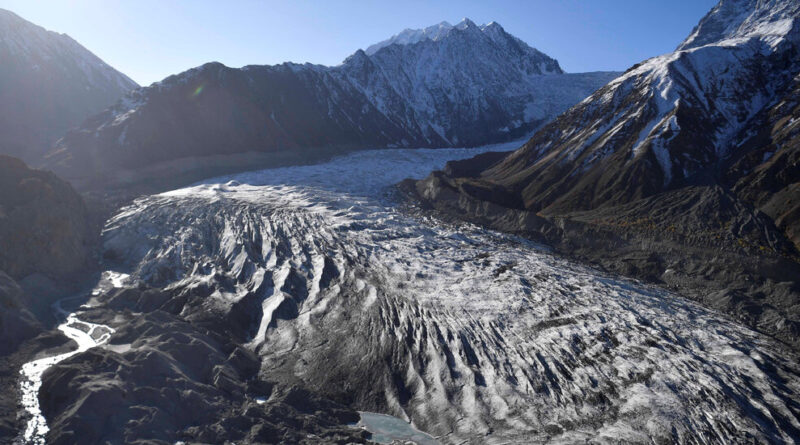New Research Shows, Ice and Snow Melting in World’s Highest Mountains at an Alarming Rate
Recent research conducted by scientists in Nepal has confirmed that the ice and snow in the world’s highest mountains are disappearing due to rising temperatures, and at a faster rate than previously anticipated. The International Centre for Integrated Mountain Development in Kathmandu has released a report revealing that glaciers in the Hindu Kush and Himalaya mountain range melted 65 percent faster between 2010 and 2019 compared to the previous decade.
This finding contributes to the growing body of evidence indicating that the impacts of climate change are accelerating and that certain changes may be irreversible. The consequences of this rapid ice and snow melt are significant for the nearly two billion people living in more than a dozen countries within the mountain region or downstream in river valleys, as their water supply relies on the melting ice and snow. Moreover, the melting glaciers are destabilizing the landscape and increasing the risks of natural hazards such as floods and landslides. These swift changes are also forcing much of the region’s unique wildlife into smaller and more precarious habitats, leading to the unfortunate extinction of some species.
Miriam Jackson, a cryosphere researcher at the International Centre for Integrated Mountain Development and one of the report’s authors, expressed concern about the speed at which these changes are occurring, stating, “Things are happening quickly. Just from two decades ago to the last decade, there have been quite significant changes. And I think that’s surprising for many people, that things are happening so fast.”
Dr. Jackson and her colleagues focused their study on an area of approximately 1.6 million square miles known as the Hindu Kush Himalaya, stretching from Afghanistan to Myanmar. The research received partial funding from the federal governments of several countries in the region, as these nations strive to comprehend how climate change is impacting their natural resources and how their populations can adapt.
In a separate report released by the World Meteorological Organization and the European Union’s Copernicus Climate Change Service, notable glacier loss was also recorded. The European Alps experienced a record amount of ice mass loss in 2022, according to The State of the Climate in Europe 2022.
The new Himalayan report builds upon previous work published by the same group in 2019, which revealed that even under the most optimistic scenario of limiting average global warming to 1.5 degrees Celsius compared to preindustrial levels, the Hindu Kush Himalaya would still lose at least one-third of its glaciers. While this estimate remains unchanged, advancements in satellite data have allowed for more precise measurements of the extent of glacier shrinkage in the region and better projections of their accelerated decline beyond 1.5 degrees of warming.
Dr. Marco Tedesco, a marine geology professor at Columbia University who was not involved in the research, commended the technical achievements of the report. He also appreciated its focus on the societal and ecological implications of rapid glacier melting, highlighting the shift in public attention from a narrow scientific focus on physical changes to a broader understanding of the impact on people worldwide.
As the mountain glaciers continue to shrink, the availability and distribution of meltwater will change. The report suggests that a turning point, called “peak water,” will be reached around 2050 when the glaciers have diminished to such an extent that their meltwater begins to dwindle. The timing and locations of meltwater in the region will also be affected, with some areas experiencing excessive water and others facing water scarcity. Dr. Santosh Nepal, a researcher at the International Water Management Institute and another author of the report, anticipates that, due to erratic rainfall patterns caused by climate change, people in the Hindu Kush Himalaya will increasingly rely on meltwater instead of rainwater, albeit for a limited period of 20 to 30 years.
In addition to the risks posed to human populations, there are other concerning factors resulting from the melting glaciers. Natural hazards, which are already a reality in the mountains, will intensify. Eroding mountain slopes and hillsides will create conditions for cascading disasters such as floods and landslides, especially when coupled with sudden shocks like earthquakes. Dr. Nepal emphasized that the emergency preparedness and response systems in the region are ill-equipped to handle such disasters.
The ecosystems of the Hindu Kush Himalaya are also unprepared for the ongoing changes. Numerous scientific studies indicate that some unique species in the region, particularly butterflies, have already gone extinct, and frogs and other amphibians are at high risk. The accumulation of data from various studies conducted across the Himalayas has been shocking, according to Sunita Chaudhary, an ecosystems researcher at the International Centre for Integrated Mountain Development and another author of the report. Dr. Chaudhary’s team concluded that by 2100, a quarter of the region’s exclusive plant and animal life could face extinction, with the Indian segment of the Himalayan mountains being particularly vulnerable.
While it may be too late to save certain species, there is still an opportunity to protect many animals and assist the millions of people whose lives are being profoundly affected by glacier loss, according to the researchers. The report includes several policy recommendations, including formal protections for biodiversity hotspots, fostering collaboration among experts in sectors like agriculture and water, and conducting further research on related topics such as permafrost.



